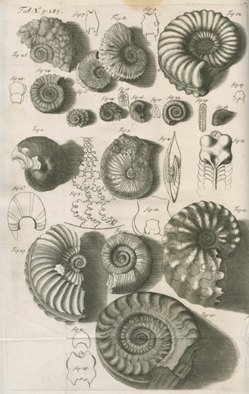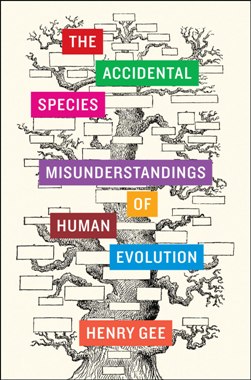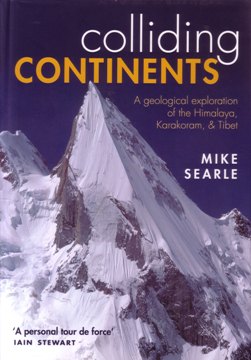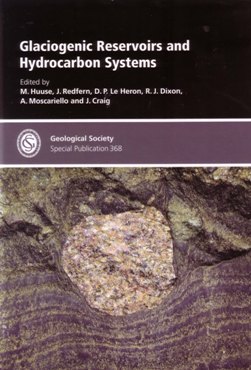 Exhibition - Fossils: the evolution of an idea
Exhibition - Fossils: the evolution of an idea
Next time you are in London visiting Burlington House, take a detour down to 7 Carlton House Terrace, home of that ‘other’ famous scientific society – the ‘Royal’. They are hosting a little gem of an exhibition, which has been sadly somewhat neglected since it opened in July but can be seen until 8 November. The good thing is that you will almost certainly have the place to yourself with an unimpeded view of the exhibits, which do need close scrutiny.
The exhibition is a great idea and nicely executed, with fossils from the University of Cambridge’s historic Sedgwick Museum, along with books and archival material from the Royal Society Library. As we all know, the 17th Century idea of a fossil differs significantly from our modern understanding. Over 300 years ago, a ‘fossil’ was literally something ‘dug up’ and was derived from the Latin ‘fossilis’. Consequently, the concept included objects of both organic and inorganic origin. And, there was a long-running debate over whether fossils were in fact stones formed within the ground, as indeed most natural mineral crystals are, or the remains of once living organisms, which had died and subsequently been buried in the ground.
The exhibition displays works by the likes of Martin Lister (1639-1702) and Edward Lhuyd (1660-1709), who argued against the organic nature of fossils and also Nicolas Steno (1638-1686) and Robert Hooke (1635-1703), who employed the new evidence-based ‘scientific methods’ of the 17th Century to demonstrate their organic nature.
It is great to see these wonderful books and illustrations, which stand alone as high points in the history of scientific illustration. The Sedgwick fossils are a real plus and give the whole exhibition a lift. With close scrutiny you can see some of the problems presented by fossils. Not only are they ‘denatured’ with loss of soft tissues and colour but they are palpably stony. And, some are broken and distorted from their original form and have crystalline internal structures.
Given the lack of understanding of the geological processes that transform organic remains into lithified fossils, it is not surprising that the issue was not at all clear. And, considering all the recent huffing and puffing about ‘Martian microbes’ in meteorites and the present question of what are or what are not the earliest known microbial fossils, we should not be sniffy about our forbears’ confusion!
Reviewed by Douglas Palmer
FOSSILS: THE EVOLUTION OF AN IDEA
Royal Society, London, 7, Carlton House Terrace. Monday 1 July to Friday 8 November 2013. Free, Monday to Friday, 10.00 to 17.00. No prior booking necessary. W:
http://royalsociety.org/events/2013/fossils-exhibition/
 The Accidental Species
The Accidental Species
Henry Gee is (among other things, including a science fiction writer, an expert on J R R Tolkien and a mean keyboard player) a vertebrate palaeontologist. He has worked at Nature for over two decades as staff editor dealing with papers on evolution and palaeontology. Better than most, he knows that human evolution, being too close to home for comfort, is a subject unlike that of any other species, and he tackles the resulting problems triumphantly in this book.
I discovered quite how different human evolution research is first hand, having written a news story for the Society’s website about ‘The Hobbit’, the dwarf human skeleton discovered on the island of Flores, and subsequently named Homo floresiensis. (Or, ‘Man from Flores’. It is one of the joys of this ‘Editor’s view’ of science that in addition to science, we also discover that the authors of this paper originally wanted to call their discovery ‘Homo florianus’, which actually means ‘Man with flowery anus’.)
I had written the story based solely on a paper published in the rival US journal Science, alleging that the specimen described was in fact not a new type of human at all, but a deformity (as Gee reveals, unsettling additions to the human bestiary are often explained away in this fashion: H. neanderthalensis, for example.)
The next thing I knew, Henry was on the blower asking me why I had not come to Nature for ‘counter comment’. It was a good question, for human evolution is an area of science where strength of feeling so overpowers available evidence as to generate heat and light in suboptimal proportions. Journalists need to treat the subject as they would politics.
The most difficult idea to purge from our minds when dealing with our own evolution is that of ‘progress’. Steve Gould did his best to boost the idea that evolution is not linear but bushy, and that living species represent the surviving twig-ends of that complex, anastomosing structure. Henry has already done his bit in this fight, dealing lucidly and entertainingly with the cladistics revolution in his earlier book Deep Time. This new work takes up the cudgels, which he grasps by the correct end, and does not beat about the bush in demolishing those who still see evolution ‘culminating’ in our blessed selves.
If you only read one book on evolution this year, make it this one. You will be dethroned. But you won’t be disappointed.
Reviewed by Ted Nield
THE ACCIDENTAL SPECIES
HENRY GEE. Published by: University of Chicago Press, October 2013. 240pp ISBN 978-0-226-28488-0 (cloth). List Price: £18.00
 Colliding Continents
Colliding Continents
This book is about the geological evolution of the Himalayas, written by one of the finest field geologists of his generation. A mountain man with extensive field experience in Oman, Syria, and Myanmar, Mike Searle is the master of the Himalayan mountain range who, with his students, has made geological maps of vast tracts of the Himalayas and found out how they work.
This is a compelling and energetic book that is difficult to put down. It describes the geology of the Himalayas in the context of many modern ideas and concepts such as middle crustal extrusion and extensional detachments. Successive chapters build an understanding of Himalayan geology interwoven with the lives of his companions and the people of the remote areas in which he worked. Complex geology is explained simply, elegantly, and accurately, and beautifully illustrated by maps, sections, block diagrams, and spectacular photographs of some majestic and vertiginous terrain. There is much supporting material including time-scale and events, basic concepts and definitions in hard-rock geology, a glossary of terms, a local glossary, and a thorough (yet not overwhelming) reference list.
Reading a book like this makes one realise how shallow and limiting is the pseudo-geology done by those who sit in front of their computers composing drivel. As Francis Pettijohn remarked, ‘the truth resides in the rocks’ and that ‘there is nothing as sobering as an outcrop’. This work is a useful lesson to those who are not prepared to sweat and get tired and dirty and try to find out the message of the rocks.
This book is a powerful combination of basic geology at the cutting edge, and the sociology of geology in a foreign mountain region. It is a work of great charm, sensitivity, scientific accuracy, literacy, and imagination.
I hope that it will stimulate the young to work at the field and rock-based core of the Earth sciences. It should be read by geologists from undergraduate to senior professor in academe, and professional Earth scientists in industry. All will learn a great deal about many aspects of life, especially about devotion and commitment to a life in real geology.
Reviewed by John Dewey
COLLIDING CONTINENTS
MIKE SEARLE. Published by: Oxford University Press, 2013. 438pp. ISBN 978-0-19-965 300-3. List Price: £25.00.
http://ukcatalogue.oup.com/product/9780199653003.do#.UhM5hP5wbcs
 Glaciogenic Reservoirs & Hydrocarbon Systems
Glaciogenic Reservoirs & Hydrocarbon Systems
Glaciogenic reservoirs are mean beasts: I well remember arriving in the Middle East to work on a field dominated by glaciogenic sediments that had proved beyond the predictive skills of many a geologist before me. Here is not the place to discuss my own efforts but I would have welcomed access to this 401 page volume, which stems from the eponymous Geological Society conference of December 2009. It contains 19 contributions, dominated by analogue studies from the North Sea and adjacent mainland and from North Africa. The volume stands out as a landmark contribution to the understanding of the relatively poorly-documented subglacial tunnel valleys (addressed in 10 of the contributions), significant as potential aquifers, shallow gas hazards and producers of seismic artefacts and which have been opened up by academic access to commercial seismic surveys.
Subsurface reservoir studies are only presented in a couple of papers which makes the volume of most value as a source of analogues and less so for addressing some of the challenges presented by reservoir equivalents – one thinks of correlation and the contribution of palynology, the rapid lateral variation of sediment bodies, the unusual textural characteristics of glaciogenic deposits (wireline log response is addressed in one contribution, by Lang et al.).
The volume starts with an excellent overview by Huuse et al. of the causes and temporal distribution of glaciations along with the distribution of glaciogenic deposits and reservoirs. There follows a case study by Pedersen to introduce glacitectionics and then an article by Pedersen on the potential of glaciogenic plays on the Norwegian shelf. A series of articles captures the latest work on Pleistocene tunnel valleys. These provide a wealth of information, largely from shallow seismic, on geometries, dimensions and architecture and document a significant variability in tunnel valley fill indicating the difficulty of developing predictive models. There then follows a series of studies on more ancient analogues: glaciomarine, glaciolacustrine, palaeovalleys and tunnel valleys, glaciogenic turbidites and outwash sands. The volume ends with a contribution on the source rock potential of Neoproterozoic de-glacial sediments.
The volume is well produced, glitches are few and far between: I could mention on page five the reference to Cryogenian deposits in Fig 5a which turn out to be Pleistocene, for example; but there is nothing that impedes understanding and I would thoroughly recommend its purchase to anyone working these fascinating reservoirs as a new source of analogue material.
Reviewed by John Marshall
GLACIOGENIC RESERVOIRS & HYDROCARBON SYSTEMS
HUUSE, M, Redfern, J Le Heron, D P Dixon R J Moscariello, A & Craig, J (eds) 2012. Geological Society, London, Special Publications, 368. W:
www/geolsoc.org.uk/bookshop. List price: £120.00; Fellow's price: £60.00; Other societies price: £72.00